What is Radio Astronomy?
- How are radio waves produced?
- What is a radio telescope?
- What do we learn from radio astronomy?
- Want to learn more?
When you gaze up at the night sky you see light given off by stars. That light has travelled across space for dozens, hundreds or thousands of years before entering your eye. When astronomers use large telescopes to probe the Universe, the faint light they gather may have come from objects millions or billions of light years away. In effect, we see objects as they were in the past as it takes that light time to travel across space. Astronomy, perhaps the oldest of Sciences, is the study of celestial objects including the planets, stars, galaxies - even the Universe as a whole. What then is radio astronomy?
When you listen to your radio, use a mobile phone or watch TV, you are using a device that receives radio waves. Radio waves are a form of electromagnetic radiation, just like the visible light you are used to seeing with your eyes. The difference in radio waves is that they have a longer wavelength and are lower in frequency than visible light. They also carry less energy. Visible light is energetic enough to help plants produce their own food through photosynthesis. Radio waves are far weaker than this so we need electronic amplifiers to help us boost their signal. Any electromagnetic with a wavelength greater than 1 mm is a radio wave.
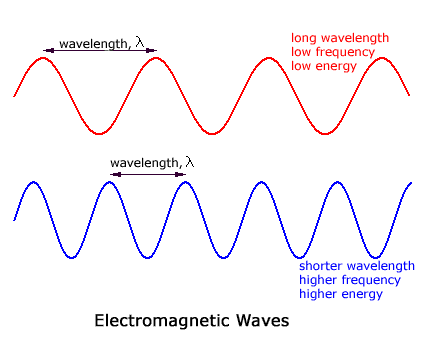
Radio waves were first detected from space in the 1930s but few scientists took the discovery seriously. The development of radar in the Second World War led to improvements in antennas and electronics. After the war many of the scientists involved started to use this equipment to investigate the radio signals coming from space. Australia was at the forefront of this work with scientists at CSIRO's Radiophysics Laboratory making many important discoveries. The science of radio astronomy was born.
How are Radio Waves Produced?
All the matter around us is made of atoms. Atoms have in turn are made of sub-atomic particles, with electrons orbiting the nucleus comprised of protons and neutrons. When charged particles such as electrons and protons accelerate by changing their speed or direction, they emit electromagnetic radiation. We can detect many forms of electromagnetic radiation that together comprise the electromagnetic spectrum. The long wavelength, low frequency hence low energy form is called radio waves. Going up in frequency and energy the electromagnetic spectrum comprises radio and microwaves, infrared waves, visible light, ultraviolet rays, X-rays and γ - or gamma rays.
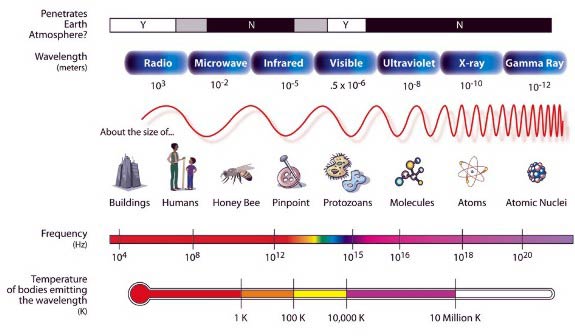
Each type of electromagnetic radiation is produced by certain conditions. Astronomers can now detect all these types of emissions, sometimes by telescopes on the ground. Some forms such as X-rays can only be detected by telescopes in space as our atmosphere absorbs them, preventing them from reaching the Earth's surface. By detecting and studying electromagnetic emissions, astronomers can determine the conditions that produced them and so increase our understanding of objects and conditions far out in space.
So what exactly do radio waves tell us? In order to answer this we need to understand how they are produced. There are two basic forms of radio emission; thermal and non-thermal.
Thermal emissions are caused by the motion of charged objects such as molecules and atoms. As all matter has some heat energy stored in it, atoms vibrate, emitting electromagnetic radiation. The more energy stored, the more the atoms vibrate and the greater the amount of radiation emitted.
When a gas is heated the energy will eventually be enough to kick out one or more of the electrons orbiting an atom. The atom now ionised and has a positive charge while the electron is now free. As negative electrons move around in this high temperature, charged gas (called plasma) they continually interact with the positive charges. Because they are thus accelerating they emit electromagnetic radiation.
Another form of thermal emission is due to the spin of electrons as they "orbit" a nucleus. An excited electron loses energy by flipping it spin back to a more stable state. The radio wave emitted in this process always has a specific discrete wavelength. An electron in a neutral hydrogen atom, for example, produces radio waves of 21cm wavelength via this process. As hydrogen is the most abundant element in the Universe this 21cm hydrogen line was one of the first radio emissions detected from space and continues to be a key wavelength for astronomers to observe.
Non-thermal sources of radio waves include synchrotron radiation, in which electrons moving near the speed of light get accelerated in strong magnetic fields. Such conditions occur in very powerful sources such as quasars, active galactic nuclei and supernova remnants, the remains of massive stars that have exploded. Geosynchrotron emissions are a related process produced by pulsars, rapidly spinning neutron stars that are remnants of more massive stars. Masers or microwave amplification by the stimulated emission of radiation are similar to lasers but at short wavelength radio frequencies or microwaves instead of visible light. Natural maser sources are sometimes found in clouds of molecules in regions where stars are forming.
What is a Radio Telescope?
A radio telescope is simply a telescope that is designed to receive radio waves from space. In its simplest form it has three components:
- One or more antennas to collect the incoming radio waves. Most antennas are parabolic dishes that reflect the radio waves to a receiver, in the same way as a curved mirror can focus visible light to a point. Antennas can be other shapes however. A Yagi antenna, similar to that used for TV reception, can be used for radio astronomy as was the case in the early Dover Heights telescopes.
- A receiver and amplifier to boost the very weak radio signal to a measurable level. These days the amplifiers are extremely sensitive and are normally cooled to very low temperatures to minimise interference due to the noise generated by the movement of the atoms in the metal.
- A recorder to keep a record of the signal. In the early days of radio astronomy this was normally a chart recorder that drew a graph on paper in ink. Most radio telescopes nowadays record directly to some form of computer memory disk as astronomers use sophisticated software to process and analyse the data.
The photos below show three types of radio telescope. The first shows one of the early telescopes used at Dover Heights in Sydney, Australia following the Second World War. A replica of the original is now on display at the site. The second is the Parkes radio telescope, star of the film The Dish. It opened in 1961 and still operates today. The dish antenna is 64m across. The third telescope is the Australia Telescope Compact Array near Narrabri, northern NSW. It opened in 1988 and comprises six 22m dishes that can be spaced out up to a distance of 6km along a rail track. This modern type of telescope where several dishes operate together is called an interferometer. Radio interferometers allow astronomers to study objects in finer detail than is possible using a single dish. The larger the total collecting area, the fainter the radio signals that can be detected.
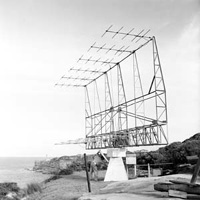
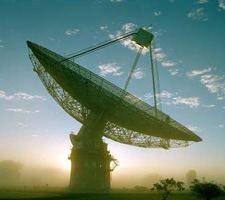
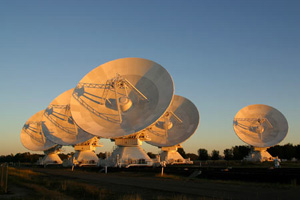
Radio dishes do not have to be as smooth or shiny as optical mirrors because the "light" that they are reflecting, radio waves, are longer in wavelength than visible light. The surface of a dish at the Australia Telescope Compact Array is smooth to within a millimeter or so rather than the surface of a glass mirror that is normally a thousand times smoother.
What do we Learn From Radio Astronomy?
Radio astronomy has changed the way we view the Universe and dramatically increased our knowledge of it. Traditional optical astronomy is great for studying objects such as stars and galaxies that emit a lot of visible light. Individual stars, however, are normally only weak emitters of radio waves. We detect radio waves from our Sun only because it is so close although its radio emissions can play havoc with radio communications on Earth when a solar storm erupts.
Cold clouds of gas found in interstellar space emit radio waves at distinct wavelengths. As hydrogen is the most abundant element in the Universe and is common in galaxies, astronomers use its characteristic emission at 21cm to map out the structure of galaxies. The image below shows part of our galaxy, the Milky Way. The orange regions are neutral hydrogen gas, the raw material from which stars are made. Astronomers refer to neutral hydrogen as HI. The bright regions surround a dark hole or void, more than 2,000 light years across, where there is no gas. Astronomers think that the hole was hollowed out over several million years by about 300 massive stars , which produced outflows of material (winds) and then finally exploded as supernovae . The void grew so large that it broke out of the disk of the galaxy, forming a chimney that extends more than 3,000 light years out of both sides of the galactic plane.
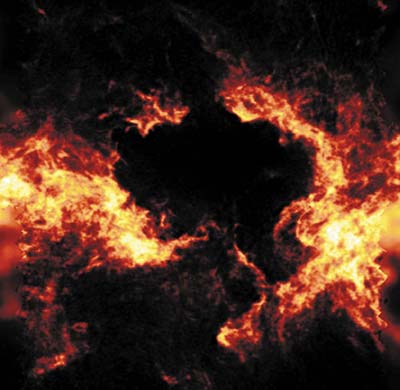
Radio waves also travel unimpeded by the dust in our galaxy so we can detect other galaxies that lay beyond the centre of our galaxy along the line of sight. These galaxies are impossible to view using visible light and optical telescopes.
Radio astronomy has detected many new types of objects. These include pulsars, rapidly spinning neutron stars that are collapsed cores of massive stars that have exhausted their fuel. Pulsars beam intense radio beams of radio waves out into space much like the beam from a lighthouse as it rotates. The Parkes radio telescope has been used to find over half of the 1,480 pulsars known. In 2003 astronomers using the Parkes radio telescope discovered two pulsars orbiting each other, the first such system known. Further observations of this exciting system will help scientists better test and refine Einstein's General Theory of Relativity. The image below shows an artist's impression of the binary pulsar system.
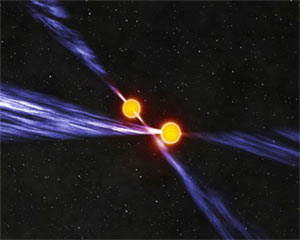
In 1963 it was also used to discover that the object 3C273 was not a star but rather an extremely bright and distant new class of object that we now call quasars. They are primordial galaxies with supermassive black holes at their centres and are among the most powerful objects in the Universe. Less energetic but related objects called active galactic nuclei (or AGNs) are now routinely studied using radio astronomy.
Astronomers trying to identify the source of interference in a radio antenna in the 1960s discovered the Cosmic Microwave Background Radiation, the afterglow of the Big Bang. As the Universe has expanded and cooled over 13.2 billion years, the thermal blackbody emission has dropped from millions or thousands of degrees to -270°C, only 2.73 degrees above absolute zero. Weak though it is, it permeates all of space. Even some of the static on your TV screen between channels is caused by this radiation.
Want to Learn More?
There are many good places to learn more about radio astronomy. Here are just a few.
Basics of Radio Astronomy is a NASA site where you can download a free introductory text book on radio astronomy.
Cambridge Physics - Discovery of Pulsars tells the story of the discovery of pulsars. It includes several animations.
Introduction to Radio Astronomy and Inteferometry is an ATNF page that gives a simple explanation of interferometry, in which two or more telescopes are linked together, works.
What is Radio Astronomy? This set of pages is from NRAO, the National Radio Astronomy Observatory, the American equivalent of Australia Telescope National Facility. It has some effective animations that show the different ways by which radio waves are produced plus answers to frequently asked questions.
